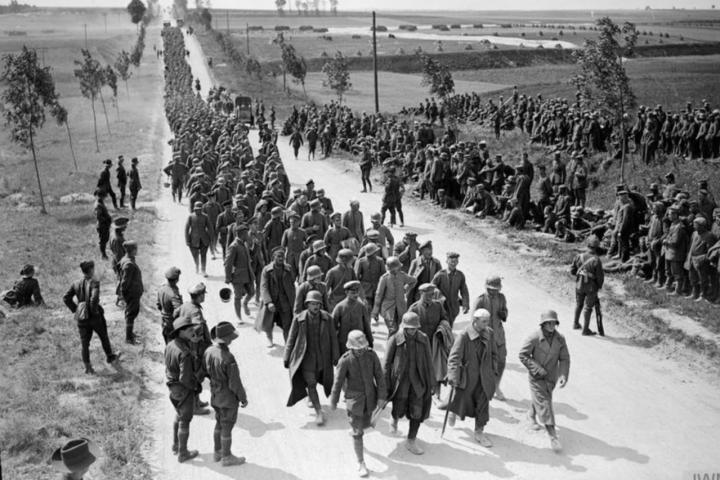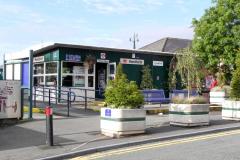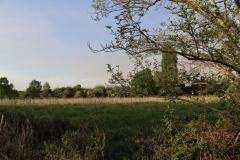
This phrase was uttered memorably by Ludendorff following the successful Allied offensive at Amiens (8th - 11th August).
Astride the Somme river the British advanced in the rougher terrain to the north and the Australians, Canadians and French over much flatter and less uneven ground to the south. At 4.20 am we went over the top in a thick fog. We advanced well over 10 miles with 44,000 casualties.
Far more worrying for the Germans was the capitulation of many of their soldiers - they lost 75,000 including about 50,000 prisoners. Working on the techniques used tellingly previously by the Australian Monash and the Canadian Currie we were perfecting the "All Arms Battle" tactics; coordinated attacks involving infantry, cavalry, nearly 600 tanks and now overwhelming air power.
We had moved formations up to the front in secret and the Germans were caught unaware, especially as there was no sustained pre-battle bombardment as in previous battle attacks. Our guns opened up exactly as our troops and tanks moved forward. Sound ranging devices, flash spotting, advances in artillery technique and aerial photographical reconnaissance enabled the Allies to determine accurately the location of the German artillery and machine gun nests.
Perhaps 504 out of 530 enemy guns were destroyed on the first day by a judicious creeping barrage combination of heavy guns, field artillery, smoke shells, shrapnel and high explosives. No longer content with keeping going at one venue Marshall Foch hardly paused for breath by attacking a succession of different objectives all with resounding success: Montdiddier (8th - 15th), Noyen (17th - 29th), Albert (21st August - 3rd September), Scarpe (26th - 30th). The "Hundred Days" advance to victory had begun. Mutinous shouts were heard (and graffiti later discovered) and this led us to believe - quite correctly - that German morale and will to fight were crumbling.
As the victorious advance proceeded until the Armistice our community lost many young men including 9 this month.
On the 1st Lieutenant Adjutant John Bell Martindale of the 2nd battalion Loyal North Lancs died aged 31 of wounds received 3 days earlier. He was the son of John and Jessie, woollen merchants of 1 Landsdowne Hawthorn Lane and had worked in his father's business in Manchester before the war. Born in St Annes he was educated there and at the University of Manchester and was once a Liberal candidate for Widnes. He had previously served in Egypt. His younger sister Beryl worked as a nurse throughout the war in Dover Hospital. John is buried at Senlis French National Cemetery and remembered in St Bart's and on the civic memorial.
Beacon Cemetery, Sailly-Laurette marks the resting place of Private Henry/Harry Dawson of the 15th battalion London Regiment (56489) the Prince of Wales Own Civil Service Rifles (90525). His father William Lees Dawson, married to Eliza, was a packer in the local bleach works. St Chad's, Handforth and the town's civic memorial record his passing on the 11th August.
Nineteen year old Private Ernest Berrisford 14th battalion Welsh Regiment (56489) and formerly of the Glamorgan Yeomanry (90525) died on the 22nd. An only child of Frederick (a carter) and Martha of Woodside Land, Mottram St Andrew, his grave can be found at Bagneux British Cemetery, Gezainicourt. He is remembered in St Bart's, the civic memorial and Wilmslow Methodist.
Private William Leslie Brewerton served with the 4th battalion Yorkshire Regiment (203641) before being transferred to the 13th battalion Royal Fusiliers of London (228465). He was killed in action on the 23rd, aged 21 and his grave is at Achiet-le-Grand Communal Cemetery Extension. Born in Wilmslow, he lived in Chorlton-cum-Hardy at the time of enlistment. His father William Arthur was an organist and music teacher who in 1911 lived with his wife Constance, 4 children and 2 servants in "Eversley", Albert Road, Wilmslow. St Bart's and the civic memorial commemorate William Leslie.
The 25th saw 2 local lads perish. The first was Private Herbert George Millin. He was born in Sarsden near Chipping Norton in 1899, but came north to Handforth with his unusually named father Uri Alfred (a blacksmith) and his Welsh mother Elizabeth. One of 4 children, like many fatalities towards the end of the Great War, he had joined one regiment only to be transferred to others in order to replenish numbers. An ex 8th Borderer (36091) he was at the time of his death with the 25th Northumberland Fusiliers (75037). Having no known grave, his passing is recorded at St Chad's, Handforth and the Vis-en-Artois memorial, Picardy.
Also in the village of Vis-en-Artois but in the cemetery is the body of Lieutenant Herbert Lee Middleton Dodson who was killed in action aged 33 on the same day as Herbert. Earlier he was in the Welsh regiment but then volunteered for the RAF where he served with the 73rd Squadron. He was the son of George, a barrister in Didsbury, who sadly died in 1907. In 1911 Herbert was living temporarily with his grandfather, a retired estate agent and his mother, Rosa Lee, in "Brookfield", Fulshaw, a large house with 2 servants. The civic memorial records his passing.
Private George Pell originally joined the Cheshires (44280) but for tactical reasons was transferred to the 16th Royal Welsh Fusiliers (77633). He was 33 when he was killed in action on the 26th. His father Joseph was a housepainter who lived with his wife Elizabeth in Brook Lane, Cumber Lane and lastly Moor Lane. One of 11 children, George was a fishmonger's assistant and married to Mary Henshall of Morley in 1912. He is buried in Caterpillar Valley Cemetery on the Somme and remembered not only in Morley, but in Wilmslow churches.
The 28th is the day Private Norman Mottram was killed in action, aged 20, fighting with the 2nd/4th South Lancs (202954). He was the 4th eldest of 5 born to William (a house painter) and Harriet of Wilmslow Road, Handforth. Buried in St Martin Calvaise British Cemetery, St Martin-sur-Cojeul, he is also remembered fondly in St Chad's and on the new town memorial.
The last to fall on the 31st of this momentous month was Private Sydney Johnson. Transferred from the 23rd Welsh Fusiliers to the 23rd Cheshires (61053), he died of his wounds. His wife was Esther (née Whitton) of "Birchwood", Nursery Lane. His father John was a coachman who lived in Chapel Lane with his wife Letitia. Sydney had one son Malcolm (1907 - 1941) and had been a salesman for Rylands drapery house before the war. He fought at Passchendale and 4th Ypres, but repulsing an attack he was severely wounded. He is buried at Nieppe-Bois British Cemetery and remembered in St Bart's, St John's and on the civic memorial.
Jon Armstrong and Alan Cooper
with a contribution from Michael Scaife
Wilmslow Historical Society










Comments
Here's what readers have had to say so far. Why not add your thoughts below.
in human life that conflict cost us all.
It is so important that we, who have enjoyed the fruits of freedom thanks to so many young men's and women's sacrifices in both World Wars and conflicts since, must not forget them.
I find your articles to be very moving and sad to read of the loss of local lads.
Ken Mackay